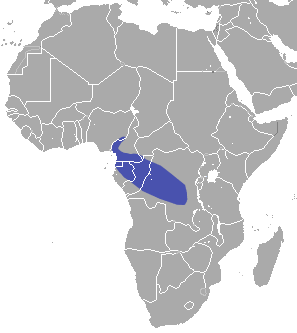
The conservation status of a group of organisms indicates whether the group still exists and how likely the group is to become extinct in the near future. Many factors are taken into account when assessing conservation status: not simply the number of individuals remaining, but the overall increase or decrease in the population over time, breeding success rates, and known threats. Various systems of conservation status are in use at international, multi-country, national and local levels, as well as for consumer use such as sustainable seafood advisory lists and certification. The two international systems are by the International Union for Conservation of Nature (IUCN) and The Convention on International Trade in Endangered Species of Wild Fauna and Flora (CITES).

The rock cavy or mocó is a cavy species endemic to eastern Brazil which has also been introduced to the Atlantic island of Fernando de Noronha.

An IUCN Red List Critically Endangered species is one that has been categorized by the International Union for Conservation of Nature as facing an extremely high risk of extinction in the wild. As of 2021, of the 120,372 species currently tracked by the IUCN, there are 8,404 species that are considered to be Critically Endangered.

The Pagai Island macaque, also known as the Pagai macaque or Bokkoi, is an Old World monkey endemic to the Mentawai Islands off the west coast of Sumatra. It is listed as critically endangered on the IUCN Red List due to its ever-shrinking habitat. Macaca pagensis formerly included the overall darker Siberut macaque as a subspecies, but this arrangement is polyphyletic, leading to the two being classified as separate species. Both were formerly considered subspecies of the southern pig-tailed macaque.

The Egyptian slit-faced bat is a species of slit-faced bat broadly distributed throughout Africa and the Middle East. It is a species of microbat in the family Nycteridae. Six subspecies are known.

The charming thicket rat is a species of rodent in the family Muridae. It is described as data deficient as Thamnomys schoutedeni. It is found in Democratic Republic of the Congo, Rwanda, and Uganda. Its natural habitat is subtropical or tropical moist montane forests. It is threatened by habitat loss.
The Kern Plateau salamander is a species of salamander in the family Plethodontidae, endemic to California, in Tulare and Inyo, and Kern Counties in the western United States.

Tate's triok, also known as the Fergusson Island striped possum, is a species of marsupial in the family Petauridae. It is endemic to Papua New Guinea. Its natural habitat is subtropical or tropical dry forests.

The mole-like rice tenrec, also known as the fossorial tenrec or hova rice tenrec, is a species of mammal in the tenrec family. Like all other tenrecs, it is endemic to Madagascar. Its natural habitats are subtropical or tropical moist forests, swamps, freshwater lakes, and irrigated or seasonally flooded agricultural land.

The Ugandan lowland shrew or Moon shrew, is a species of mammal in the family Soricidae. It is found in Kenya and Uganda. Its natural habitats are subtropical or tropical swamps and montane forests.

The Mount Cameroon forest shrew or arrogant shrew, is a species of mammal in the family Soricidae endemic to Cameroon. Its natural habitat is subtropical or tropical moist montane forests.

The greater forest shrew is a species of mammal in the family Soricidae found in Cameroon, the Central African Republic, the Republic of the Congo, Equatorial Guinea, Gabon, and Nigeria. Its natural habitat is subtropical or tropical moist lowland forest.
Mesoperipatus is a monospecific genus of velvet worm in the Peripatidae family, containing a single species Mesoperipatus tholloni. It is found in Gabon, making it the only known species of velvet worm in the tropics of Africa, and the only known species of peripatid velvet worm in Africa. Females of this species have 24 to 27 pairs of legs; males have 23 or 24. This species is viviparous, but too little is known of its embryology to describe its reproductive mode in any more detail; the presence of a placenta, for example, has not been confirmed.
Plicatoperipatus is a monospecific genus of velvet worm containing the single species Plicatoperipatus jamaicensis. It is endemic to Jamaica. Females of this species can have as many as 43 pairs of legs, the maximum number found in the phylum Onychophora. In a large sample collected in 1988, however, females ranged from 35 to 39 leg pairs, with 37 as the mean and the most common number, and males ranged from 31 to 37 leg pairs, with 35 as the mean and the most common number. This species ranges from 25 mm to 65 mm in length. In the 1988 sample, the mean length for males was 33 mm, and the mean length for mature females was 51 mm. This species is viviparous, with mothers supplying nourishment to their embryos through a placenta.
The Dlinza Forest pinwheel is a species of very small, air-breathing, land snail, a terrestrial pulmonate gastropod mollusk in the family Charopidae.
Trachycystis is a genus of small air-breathing land snails, terrestrial pulmonate gastropod mollusks in the family Charopidae.
Trachycystis haygarthi is a species of very small, air-breathing, land snail, a terrestrial pulmonate gastropod mollusk in the family Charopidae.

Poeciliopsis prolifica, or the blackstripe livebearer, is a species of small freshwater fish in the family Poeciliidae. It is endemic to Mexico. It is a viviparous species and the female can have several clutches of young developing internally at the same time, hence the specific name prolifica, from the Latin proles, "offspring" and ferax, "rich, fruitful" in reference to the great number of young produced.












